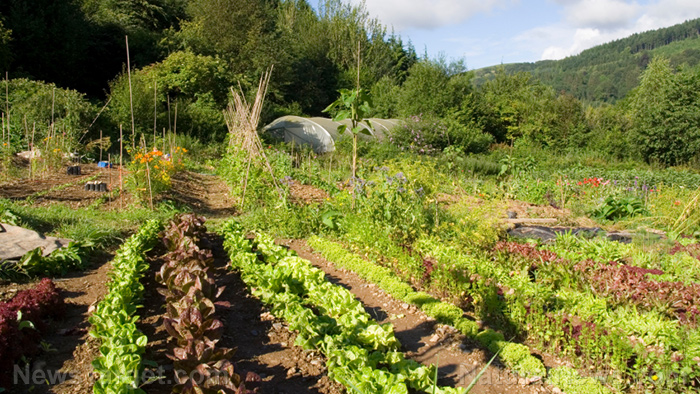Most preppers often include tarps in a bug-out bag to be used as material for a makeshift shelter or for emergency repairs.
But according to Bob Rogers of Survivopedia, tarps can also be used in your home garden.
What is tarping?
Rogers writes about tarping, which he discovered during a visit to a friend’s farm in Oregon. His friend used tarping for weed control and season extension, giving him an advantage over his fellow farmers.
Tarping is a method that involves covering crop beds with tarps. This then warms the soil and gets rid of spring-emergent weeds a lot earlier than other conventional methods.
This allows Rogers’ friend to bring his produce to market before his competitors, which also gives him a head start in sales.
Rogers’ then used this newly discovered method when he joined a project that aimed to produce food for the local food pantry network.
The project helped Rogers practice what he learned from researching tarping because it involved producing crops on a market-garden scale. The experience helped him see the practical applications of tarping in a real-world setting.

Rogers advised that the adoption of tarping in agriculture varies depending on important factors like the crops being grown, the local climate and soil type.
While tarping is a relatively new technique in agriculture and its use may be more widespread in certain regions, the method can be used in any state where it may offer benefits for the agricultural process.
How Rogers used tarping
For the food production project, Rogers obtained a 100×24-foot silage cover that has been in use ever since.
The cover was worn, but it served its purpose well for many years. The silage cover allowed him to prepare the fields for food production in the spring without needing manual weeding or a tractor.
The cover allowed Rogers to harvest fresh summer vegetables for those in need with minimal expenses and the help of volunteers with limited gardening experience.
The experiment also made Rogers realize that he still had a lot to learn about how to use tarps effectively on a farm site. This inspired him to look for a location where he could observe experts use tarps.
In 2018, Rogers attended a farm tour in California. The owners of the thriving Community Supported Agriculture operation were recognized advocates and speakers for no-till farming and used tarps frequently on their market farm.
The owners refined the tarping technique and shared their insights on the timing and duration of tarping.
Rogers was drawn to the use of tarps because he is also an advocate of repurposing materials so they don’t end up in a landfill. He also expanded their tarping options by acquiring 14-by-48-foot recycled billboards from a store that was planning to throw them away.
Rogers used the tarps to manage the large-scale projects he designed in his permaculture design classes like a one-acre forest garden, cropping areas and an orchard. The tarps helped Rogers avoid the environmental impact, costs and maintenance often linked to the use of common tools like a tractor and farming implements.
Here are several tasks that you can accomplish with tarps instead of relying on a tractor.
Use tarps for natural weed control
Traditionally, weed control with a tractor involves mowing or spraying. Mowing requires repeated maintenance and this results in soil compaction, takes a lot of your time and consumes fuel.
Meanwhile, spraying involves handling, cleaning and storing chemicals and equipment safely to use herbicides.
Alternatively, with tarping you just need to observe when the first flowers appear. This signifies the start of seed formation.
Next, you must place a tarp over the area and secure it using your preferred methods. For example, you can secure tarps with heavy objects like sandbags or stones placed around the edges.
Most weeds can be eliminated by the darkness under the tarp and will eventually die. As a bonus when using tarping, the dead weeds become food for earthworms and soil shredders.
These worms transport the nutrients from the weeds into their burrows, where they are easily accessible to root systems that need them. The worms transform the weed biomass into a layer of moist, nutrient-rich castings.
The tarp also helps protect worms from the elements, birds and other predators. Once the weeds are gone, roll back the tarp to reveal a weed-free surface that has been micro-fertilized and is ready for planting.
To try this on your garden or farm, roll out the tarp. After several weeks, roll up the tarp and plant. The tarping of weeds before seed formation helps deplete the soil’s seed load over time.
After two years, only a handful of the targeted weeds will emerge.
Use tarps for cover crop termination and nutrient cycle
Rogers and other volunteers used fava beans when overwintering crop beds and the beans have an important role in their soil biology and nutrient cycling strategy.
The beans provide enough nitrogen to restore what was consumed during the previous growing season. Beans also helped sustain the soil biology that relies on root secretions and keeps it thriving throughout the winter so it can quickly activate when new crops are planted in spring.
The migration of mycorrhizal fungi between the crop roots and cover crop roots is seamless.
One problem you may face with winter cover crops is knowing when to end them at the right time so they fully decompose and provide nutrients for spring planting.
During winter, which is often the wettest season, it can be hard to access fields with a crop termination tool like a roller crimper. To address this, use a tarp to cover the growing cover crop.

The darkness will end the crop and give a warm and protected environment for decomposers that will transform the nutrient-rich biomass into worm cheese.
Speed up the decomposition process by shredding the cover crop with a battery-powered string trimmer before covering it. Doing this helps shorten the time by a week or more.
Use tarps for seedbed preparation
When you roll back the tarp, you will find a lush layer of newly formed worm castings.
Rogers shared that the roots of last year’s crop and the fava beans, which had their nitrogen-generating nodules, are still in place. The beans then contribute to the micro-manure that also includes the root zone of the crops.
This type of bioturbation (the reworking of soils and sediments by animals or plants) acts as a harrow to create a seed bed. In agriculture, a harrow is a farm implement that pulverizes soil, breaks up crop residues, uproots weeds and covers seed.
Additionally, it eliminates the need for a tractor when it’s not appropriate to use one in the field.
Use tarps to get rid of invasive plants
It can be hard to eliminate invasive plants, especially when they are in dense thickets on steep hill slopes and creek sides, where it can be difficult to remove them with a tractor brush hog.
Mowing the vegetation also produces a large pile of flammable material and stimulates the root system. Fortunately, tarping can help solve this issue.
Use a trap to cover the intact plant or cut the main canes with loppers. Use old tires or large rocks to secure the tarp and effectively stop the growth of the invasive plants.
Vegetation will quickly decompose under the tarp during the wet season. Rogers added that it is best to carry out this project in the fall before the winter rains.
In the spring, new growth may emerge from the roots, but cutting off the new canes will weaken the plant.
Sometimes, it may take several years for the roots to die, but the size of the returning plants will become more manageable. After another season, you may be able to eliminate all invasive plants.
Look for hemp-based tarps
Ensure the sustainability of tarping on your garden or farm by carefully considering the material used for the tarps. Most tarps are made of plastic, but you can address this by using alternative fabrics made from hemp.
Hemp-based tarps are usually made using a combination of hemp fiber and natural materials like cotton or flax. The fibers are woven together to create a durable material that is suitable for use as a tarp.
The longevity of hemp-based tarps depends on several factors, including the quality of the hemp fiber used, the weaving process and how often you use the tarp. Hemp is known for its durability and strength.
If you have hemp-based tarps, they will last for several years with proper care and maintenance.
Other ways to use tarps in your garden
Here are more ways to use tarps in your home garden:
Composting
Use tarps to cover compost piles and retain heat and moisture. This helps promote decomposition.
Crop protection
Use tarps to cover crops like strawberries during heavy rain and wind events. This will prevent damage to the crops.
Moisture conservation
Use tarps to cover the soil and retain moisture, especially in arid regions where water is scarce.
Tarps are affordable and versatile, making them a valuable tool in your home garden or farm.
Watch the video below for tips on how to use leaves in your garden.

source : Zoey Sky



